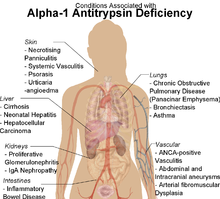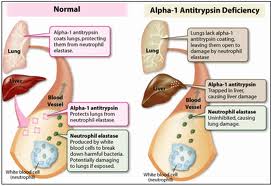Alpha 1-Antitrypsin Deficiency (A1AD) is one of the many genetic disorders that hamper the proper functioning of proteins and enzymes within the body. Read on to know all about the condition, how it is inherited and how can it be treated.
Alpha 1-Antitrypsin Deficiency Definition
Page Contents
- 1 Alpha 1-Antitrypsin Deficiency Definition
- 2 Alpha 1-Antitrypsin Deficiency Incidence
- 3 Alpha 1-Antitrypsin Deficiency Causes
- 4 Alpha 1-Antitrypsin Deficiency and Genetics
- 5 Alpha 1-Antitrypsin Deficiency Symptoms
- 6 Alpha 1-Antitrypsin Deficiency Diagnosis
- 7 Alpha 1-Antitrypsin Deficiency Differential Diagnosis
- 8 Alpha 1-Antitrypsin Deficiency Treatment and Management
- 9 Alpha 1-Antitrypsin Deficiency Prognosis
- 10 Alpha 1-Antitrypsin Deficiency Complications
- 11 Alpha 1-Antitrypsin Deficiency Prevention
- 12 Alpha 1-Antitrypsin Deficiency Life Expectancy
- 13 Alpha 1-Antitrypsin Deficiency Support Groups
- 14 Alpha 1-Antitrypsin Deficiency Pictures
Alpha 1-Antitrypsin Deficiency is a hereditary disease in which the production of the alpha-1 antitrypsin or A1AT protein is hampered due to some genetic reasons. It is also referred to asα1-Antitrypsin Deficiency and A1AD. Reduction in the normal A1AT activity in lungs and blood leads to various health problems. The protein may also accumulate in the liver, where it is produced and result in different symptoms.
The condition is also referred to as A1AT deficiency. It can occur in various forms and degrees depending on the inheritance pattern followed by it as the disorder is a co-dominant trait. Severe A1AT deficiency results in COPD or panacinar emphysema along with various liver disorders in adults with the disease. It can also occur in children.
Alpha 1-Antitrypsin Deficiency Incidence
A1AD occurs in people from all over the world, although the prevalence of the disease varies depending on population. One in every 1,500-3,500 people with European ancestry develops A1AD every year. It does not generally affect individuals of Asian descent. Iberian, northern European and Saudi Arabian people also have a greater risk of having the disease. The carrier frequency is estimated to be as high as 1 in every 25 individuals in these populations. Both men and women are equally affected by α1-Antitrypsin Deficiency.
Alpha 1-Antitrypsin Deficiency Causes
It is caused by mutations in certain genes which obstructs the production of alpha-1 antitrypsin protein. The exact factors responsible for the gene mutations are still not known. Experts have suggested some possible risk factors including obesity, smoking, alcohol consumption as well as exposure to dust and chemicals, which may trigger the genetic mutation. A1AD is sometimes associated with Vitamin K deficiency, especially in infants.
Alpha 1-Antitrypsin Deficiency and Genetics
Mutations in the SERPINA1 gene lead to A1AD. This gene controls the instructions necessary for producing the alpha-1 antitrypsin protein that is responsible for protecting the body against the powerful enzyme named neutrophil elastase. The neutrophil elastase enzyme, released by the white blood cells, fights various infections in the body. In some abnormal situations, however, it may mistakenly attack the normal tissues of various organs (mainly the lungs). The alpha-1 antitrypsin protein controls the functioning of this enzyme to prevent it from attacking healthy tissues.
The SERPINA1 gene mutations disrupt the A1AT productions which results in shortage of the protein. Sometimes, the structure of the protein is changed due to the genetic mutation that makes it impossible for the protein to perform its regular tasks. As a result, the neutrophil elastase attacks and destroys the alveoli and leads to various lung diseases. Abnormal buildup of A1AT protein in the liver may also occur.
The condition follows an autosomal co-dominant inheritance pattern, meaning that there are 2 active (expressed) versions of the SERPINA1 gene and both contribute to the familial trait.
The most common allele of this gene in called M and it produces sufficient amounts of A1AT protein necessary for the normal functioning of the body. Under normal circumstances, each individual has 2 copies of M allele in every cell. However, other versions of SERPINA1 gene have other alleles that produce less amounts of A1AT. For example, the S allele produces lower levels of the protein while the Z allele makes very little A1AT protein. People who have 2 copies of Z allele in every cell are at great risk of developing α1-Antitrypsin Deficiency. The SZ allele combination can produce adequate amounts of alpha-1 antitrypsin to prevent the occurrence of this disorder in non-smokers. However, smokers with SZ combination are likely to have the genetic disease.
Alpha 1-Antitrypsin Deficiency Symptoms
A1AT deficiency leads to a number of symptoms due to tissue damage in various organs. A1AD patients often have Emphysema due to the alveoli (air sac) damage. The common signs and symptoms are mentioned below:
- Coughing
- Shortness of breath
- Symptoms of Chronic Obstructive Pulmonary Disease (COPD)
- Wheezing
- Symptoms of Cirrhosis (severe liver disease)
- Drowsiness
- Fatigue
- Barrel shaped chest
- Weight loss without any apparent reason
- Intestinal bleeding
- Coma (rare)
Neonates with A1AD can have various symptoms of non-specific liver disease, like:
- Jaundice
- Enlarged liver
- Pale stools
- Excessive bleeding
This condition is known as “neonatal hepatitis syndrome”, starting sometime between 4 days and 6 weeks after birth. It can lead to rapid liver failure in some infants.
Alpha 1-Antitrypsin Deficiency Diagnosis
The diagnosis of A1AD is difficult as it generally does not lead to any symptoms before considerable damage is done by the abnormal functioning of neutrophil elastase. Doctors may fail to identify A1AD even after the symptoms start appearing as they are mistaken for some other lung or liver disorder. Physicians may ask different questions regarding the risk factors of the patient, the present symptoms and any family history of the disease. The presence of α1-Antitrypsin Deficiency is suspected in the following cases:
- If the patient has Emphysema before reaching 45 years of age
- If the patient develops Emphysema without any history of smoking or exposure to toxins
- Emphysema, Hepatitis or liver in individuals with a family history of A1AD
A thorough physical examination helps the physician to detect symptoms like a barrel shaped chest and wheezing. The following diagnostic and imaging tests are used for this purpose:
- Blood test, for determining the levels of Alpha-1 antitrypsin
- Arterial blood gases
- CT scan of chest
- Chest x-ray
- Lung function test
- Genetic testing
Alpha 1-Antitrypsin Deficiency Differential Diagnosis
A diagnostician should take care to rule out the following disorders while making the diagnosis for A1AT deficiency:
- Bronchitis
- Chronic Bronchitis
- Kartagener Syndrome
- Bronchiectasis
- Emphysema
- Nonphysiologic neonatal jaundice
- Chronic Obstructive Pulmonary Disease
- Cachexia
- Hepatitis caused by unknown factors in children
- Nephrotic Syndrome
The above conditions result in symptoms that are quite similar in nature to those associated with A1AD. Differential diagnoses should aim at ensuring the absence of these disorders.
Alpha 1-Antitrypsin Deficiency Treatment and Management
There is no specific treatment option which can cure the A1AT deficiency. However, the symptoms and complications associated with it can be treated with various medications and therapies. Prompt management of the lung infections helps to protect the lungs from severe damage. Many of the treatment options used in this condition are similar to those used for treating COPD. Patients usually receive the following treatments for managing the symptoms:
- Inhaled steroids and inhaled bronchodilators, which relieve the associated breathing problems by opening the blocked airways. They can also be used for treating COPD and asthma associated with A1AD.
- Pulmonary rehabilitation, performed by experts, enables patients to cope with the disease and manage the symptoms.
- Oxygen support, in some severe cases, to fight the breathing difficulties.
- Surgical intervention, which may be necessary if the lungs are severely damaged. Lung transplantation surgery can be performed to treat lung failure.
- Kidney and liver transplant may also be necessary in case of serious organ damage.
Patients with A1AT related lung problems are sometimes treated with augmentation therapy. However, this treatment is not used for treating patients without these lung diseases. The augmentation therapy increases the level of A1AT protein in the lungs and blood. The usefulness of this treatment is still under study.
A1AD patients are strongly advised to avoid smoking and alcohol as it can aggravate the symptoms. Regular exercise improves the functioning of the immune system, which can provide better protection from infection. It is also important to follow a healthy diet consisting of fresh vegetables and fruits. Individuals with mild symptoms sometimes prefer natural and Ayurvedic treatment for managing A1AD.
Alpha 1-Antitrypsin Deficiency Prognosis
People with A1AD often do not develop the symptoms and do not know they have the disorder. In these cases, the condition does not cause any liver and lung disease. However, it can sometimes lead to life threatening complications without timely treatment. The outlook or prognosis is positive with treatment. A1AD patients can lead a long and normal life with proper management of the symptoms, along with certain dietary restrictions and lifestyle changes.
Alpha 1-Antitrypsin Deficiency Complications
The possible complications of α1-Antitrypsin Deficiency are:
- Bronchiectasis
- Cirrhosis / liver failure
- Pneumothorax
- Liver cancer
- Lung cancer
- Emphysema
- Severe airflow obstruction
- Pneumonia
- Respiratory failure
Some treatment procedures like augmentation therapy can give rise to some side effects like headache, joint pain and lower back pain in some patients.
Alpha 1-Antitrypsin Deficiency Prevention
It is not possible to prevent A1AD, as it is an inherited disease. Couples with a family history of the syndrome should consider genetic counseling to assess their chances of giving birth to a baby with A1AT deficiency. Gene reviews may be helpful for finding out if one or both parents are carrying the defective gene. These measures make it possible to diagnose and treat the disorder in infants as early as possible.
Genetic reviews also help people to find out if they have abnormal pair of alleles in their genes. People having the risk factors should avoid smoking as it may trigger the onset of A1AD. Such individuals should also avoid exposure to secondhand smoke, dust, toxic fumes and chemical substances that one may inhale.
Pneumococcal and flu vaccines are used for preventing the occurrence of various complications that can worsen the condition of patients.
Alpha 1-Antitrypsin Deficiency Life Expectancy
The life expectancy of patients is not usually affected by this disorder. Sufferers have a normal lifespan and can participate in all the normal daily activities. However, severe organ damage caused by the A1AT deficiency can turn fatal. Neonates with the condition require prompt treatment. Otherwise, increased neutrophil elastase activity can lead to life- threatening complications.
Alpha 1-Antitrypsin Deficiency Support Groups
There are many forums and foundations that spread awareness about this condition by providing facts and information about the origin and risk factors of the genetic mutation. These organizations also provide guidelines about various treatment measures for the symptoms and complications. Some of them are mentioned below:
Alpha-1 Association
2937 SW 27 Avenue
Suite 106
Miami, Florida 33133
Tel: (305)648-0088
Fax: (305)648-0089
Email: [email protected]
Website: http://www.alpha1.org
Alpha-1 Foundation
2937 SW 27th Avenue
Suite 302
Miami, Florida 33133
United States
Tel: (305)567-9888
Fax: (305)567-1317
Email: [email protected]
Website: http://www.alphaone.org
Alpha-1 Research Registry
C/o Medical University of South Carolina
96 Jonathan Lucas St., Suite 812-CSB, MSC 630
Charleston, South Carolina 29425-6300
United States
Tel: (843)792-0260
Fax: (843)792-0297
Email: [email protected]
Website: http://www.alphaoneregistry.org
American Liver Foundation
39 Broadway, Suite 2700
New York, New York State 10006
United States
Tel: (800)465-4837
Fax: (212)483-8179
Email: http://www.liverfoundation.org/contact/
Website: http://www.liverfoundation.org
Alpha 1-Antitrypsin Deficiency Pictures
The following images show how an increased functioning of neutrophil elastase affects various internal organs.
Picture 1 – Alpha 1-Antitrypsin Deficiency
Picture 2 – Alpha 1-Antitrypsin Deficiency Image
Alpha 1-Antitrypsin Deficiency is a serious condition associated with various complications. Early diagnosis, followed by timely treatment, is very important for the normal life expectancy of the patient. Individuals with the disorder can live a normal life with suitable treatment.
References:
http://www.bbc.co.uk/health/physical_health/conditions/alpha1.shtml#causes_and_risk_factors
http://www.nhlbi.nih.gov/health/health-topics/topics/aat/
http://health.nytimes.com/health/guides/disease/alpha-1-antitrypsin-deficiency/overview.html
http://ghr.nlm.nih.gov/condition/alpha-1-antitrypsin-deficiency


